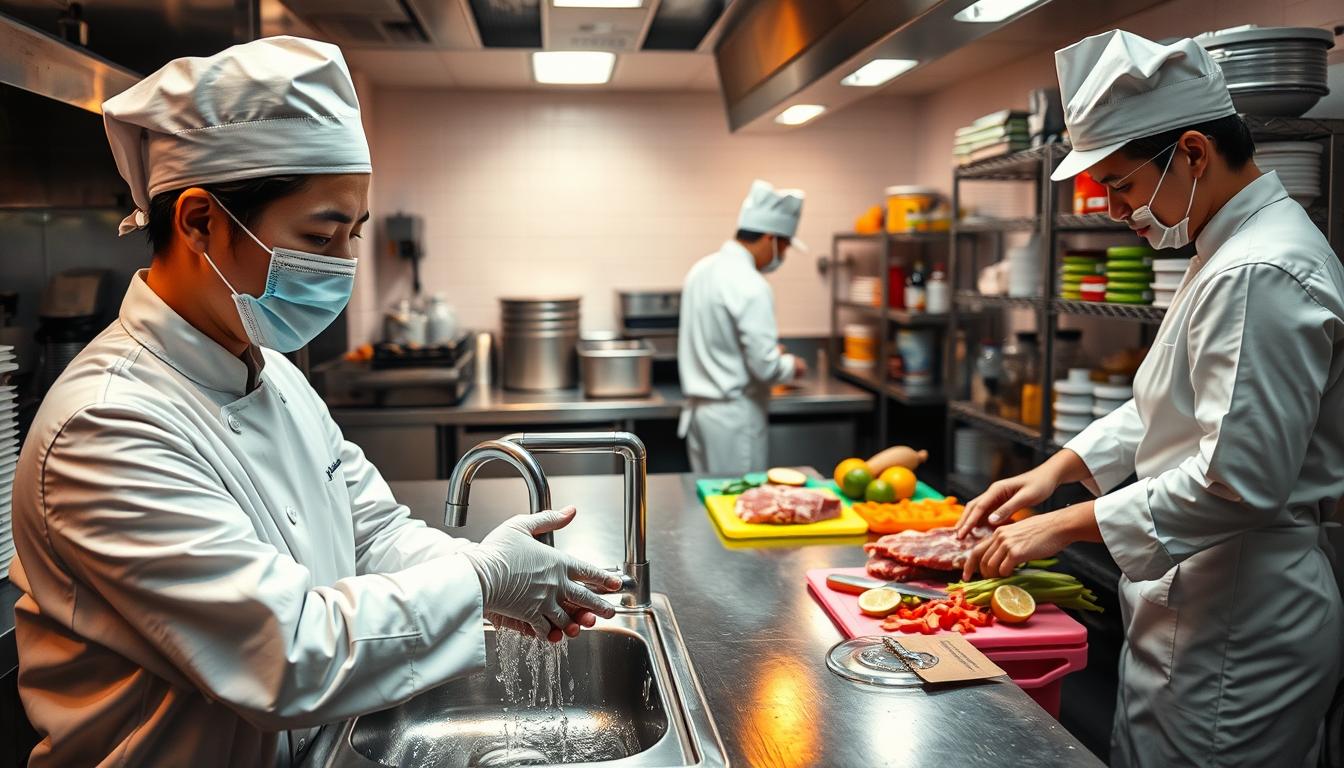Did you know 48 million people in the U.S. experience foodborne illness yearly? That’s like every sixth person you meet. What’s worse, invisible germs on countertops, knives, and even your fridge handle cause most of these cases. Simple mistakes like using the same cutting board for raw chicken and veggies can trigger a chain reaction of contamination.
Bacteria like Salmonella and E. coli thrive where you least expect them. They survive for hours on sponges, linger on faucet handles, and spread through unwashed hands. The good news? Four basic steps – clean, separate, cook, and chill – can slash your household’s risk dramatically.
Your grocery bag hides dangers too. Raw meat juices dripping onto produce or ready-to-eat foods create silent threats. Proper storage and handling from store to plate form your first defense line. Smart choices today prevent tomorrow’s ER visits.
Key Takeaways
- Foodborne pathogens cause 600 million global illnesses annually, many starting in home kitchens
- High-risk items like raw meat require separate storage and prep zones
- Color-coded cutting boards reduce accidental germ transfer by 62%
- Refrigerators should stay below 40°F to slow bacterial growth
- Handwashing with soap for 20 seconds eliminates 90% of harmful microbes
Understanding Cross-Contamination and Its Risks
Germs don’t leap between surfaces on their own – your kitchen habits determine their path. Three silent threats dominate home cooking spaces: raw ingredients, tools, and human contact. Each creates invisible highways for pathogens like E. coli and Listeria.

Defining Cross-Contamination in Your Kitchen
Bacterial transfer happens when you let high-risk items mingle with safe ones. Food-to-food contamination often starts with raw poultry dripping juices onto vegetables. Equipment risks emerge when you slice bread on a board previously used for meat without proper cleaning.
People spread germs too. Your phone, apron, or unwashed hands can introduce harmful bacteria to ready-to-eat meals. A 2023 USDA study found 34% of home cooks contaminated spice containers while handling raw ground beef.
Common Sources of Bacterial Transfer
Leafy greens and bean sprouts carry natural bacteria that multiply if washed improperly. Deli meats and soft cheeses risk listeria growth when left unrefrigerated. Wooden cutting boards harbor 200% more microbes than plastic versions if not sanitized correctly.
Survival times shock many home chefs:
- Salmonella: 4 hours on counters
- E. coli: 24 hours on sponges
- Listeria: 10 days in refrigerator condensation
“The danger isn’t seeing bacteria – it’s forgetting they exist on every surface,” notes food safety expert Dr. Ellen Parks.
Practical Steps for Preventing Cross-Contamination in the Kitchen
Effective kitchen safety begins with intentional habits. These three strategies form your daily defense against invisible threats.

Handwashing Techniques and Best Practices
Scrub with plain soap and water for 20 seconds – about the time it takes to hum “Happy Birthday” twice. Clean under nails and between fingers where 95% of germs hide. Wash before touching ingredients, after handling raw meat, and whenever switching tasks.
Separating Raw Ingredients from Ready-to-Eat Foods
Designate specific cutting boards using this simple system:
- Red: Raw meat and poultry
- Blue: Seafood
- Green: Vegetables and fruits
- White: Bread and cooked foods
Store raw proteins in sealed containers on your refrigerator’s bottom shelf. Never rinse chicken – it splashes bacteria up to 3 feet.
Sanitizing Surfaces, Utensils, and Cutting Boards
After preparing raw ingredients:
- Wash tools with hot, soapy water (120°F minimum)
- Sanitize with 1 tablespoon bleach per gallon of water
- Air-dry completely before reuse
Replace worn boards with deep grooves. Studies show proper cleaning reduces bacterial counts by 99.9% on kitchen surfaces.
Implementing Safe Cooking and Temperature Practices
Your stove dials hold more power than you realize. Precise heat control destroys harmful bacteria while preserving flavor. Master these techniques to protect your meals from invisible threats.
Using a Food Thermometer Correctly
Never guess doneness by color. Insert the food thermometer into the thickest meat portion, avoiding bones and fat. For burgers, check multiple patties. Ground beef needs 160°F, while whole cuts like steak require 145°F followed by a 3-minute rest.
Microwave users: stir food halfway through cooking. Let it stand covered, then verify all sections reach 165°F. Thermal “cold spots” in reheated leftovers often harbor surviving pathogens.
Maintaining Safe Cooking and Holding Temperatures
Keep cooked dishes above 140°F until serving. Use chafing dishes or slow cookers for buffet setups. Chill perishables within two hours – one hour in summer heat.
Your refrigerator should maintain 40°F or lower. Store leftovers in shallow containers for rapid cooling. Consume within four days or freeze for longer storage. Reheat thoroughly to 165°F, checking multiple spots with your thermometer.
“Temperature control is the silent guardian against foodborne threats – respect it like your best kitchen knife”
Appliance thermometers provide essential verification. Test fridge/freezer zones monthly. Frozen food stays safest at 0°F, halting bacterial growth completely.
Conclusion
Simple daily actions build a strong defense against invisible threats. Mastering food safety involves multiple layers: thorough handwashing, smart separation of ingredients, and precise temperature checks. These steps protect vulnerable family members like toddlers and grandparents from severe health risks.
Always sanitize tools after contact with raw items. Bacteria linger on counters and utensils longer than most realize. Store ready-to-eat meals above raw proteins in the fridge, and consume leftovers within four days.
Stay informed about product recalls through FDA alerts. Your vigilance creates a kitchen where meals nourish without hidden dangers. Consistent habits become second nature, turning meal prep into a shield against illness.
Remember – every clean surface and washed hand matters. Your choices today determine tomorrow’s well-being. Keep learning, stay alert, and cook with confidence.



